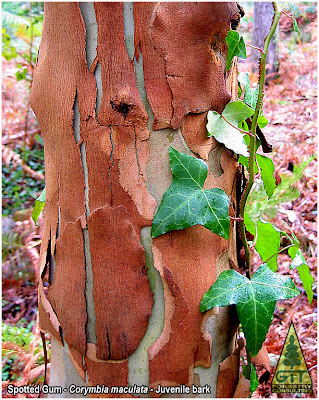Sycamore Eucalypts: ornamental spotted patterns
Gustavo Iglesias Trabado 
GIT Forestry Consulting - Consultoría y Servicios de Ingeniería Agroforestal - www.git-forestry.com - EUCALYPTOLOGICS

GIT Forestry Consulting - Consultoría y Servicios de Ingeniería Agroforestal - www.git-forestry.com - EUCALYPTOLOGICS
An interesting eucalypt species from both a timber production perspective but also an ornamental point of view, Corymbia maculata (known as Eucalyptus maculata from 1844 to 1995) sets its flower buds and later its seed capsules in panicles also known as corymbs. Individual flowers and capsules are normally grouped in 3's or 4's, but many times a pair of groups grow from the same point of the branchlet, giving appeareance of groups of 7's. Globose and urn shaped capsules of medium size normally develop in dense clusters where previously medium sized white flowers attract nectar browsing fauna that involuntarily cooperate with this eucalypt for pollination.
 Urceolate and globose infrutescences of Corymbia maculata (ex Eucalyptus maculata)
Urceolate and globose infrutescences of Corymbia maculata (ex Eucalyptus maculata)The spotted gum receives its name for a relatively unusual bark type within eucalypts. "Maculata" literally means "spotted", and that is the appeareance of mature bark, showing patches of grey, brown, white and yellow that give it a ressemblance to a totally different tree, Acer pseudoplatanus, the Sycamore Maple.
 Fibrous reddish juvenile bark of Corymbia maculata (ex Eucalyptus maculata) shedding to reveal the first patches of grey and brown underneath.
Fibrous reddish juvenile bark of Corymbia maculata (ex Eucalyptus maculata) shedding to reveal the first patches of grey and brown underneath.Its diverse natural habitat spreading from Eastern Victoria along New South Wales to Southern Queensland suggests variation for parameters like cold hardiness, and its altitudinal distribution from sea level to 1000 m. elevation can contribute to this thought. But it is mostly a coastal species with a relatively low tolerance to frost, so care must be put in tracing seed back to the parent trees if trying to grow it in borderline areas.

Broad lanceolate ruffled and hairy underneath juvenile leaves of Corymbia maculata (ex Eucalyptus maculata) on a two year old coppiced specimen
A vigorous and big sized tree, its best ornamental feature, bark, can be displayed at its best when planted in alleys, making sure there is room enough for symmetric crowns to develop. Individual specimens are better planted in ample gardens in order to achieve full crowns.
We include it in category EUCF (absolute minima from 0ºC to -5ºC) for safe cultivation, but suitable seed provenances from mid to high elevations in the inland ranges of Victoria or Southern NSW could show a bit higher tolerance to cold, so it could be tried with caution in the mildest part of ATL1 zone (absolute minima from -5ºC to -10ºC). In our experience it can survive temperatures as low as -7ºC, but losing its yearly growth to later resprout from lignotuber, so not easily achieving tree size. A very high amount of plant losses happens when temperatures approach -10ºC. Safe zone is then around -5ºC.
In Galicia (Northwestern Spain) it is cultivated infrequently, wich is a shame, and best specimens are always present in coastal areas corresponding to USDA Zone 9.
Larmour J S, Whitfeld S J, Harwood C E, Owen J V (2000). Variation in frost tolerance and seedling morphology of the spotted gums Corymbia maculata, C. variegata, C. henryi and C. citriodora. Australian Journal of Botany 48, 445–453.
Hill, K D, Johnson, L A S (1995). Systematic studies in the eucalypts 7. A revision of the bloodwoods, genus Corymbia (Myrtaceae). Telopea 6:185–504
 ORNAMENTAL EUCALYPTUS WORLDWIDE: BARK
ORNAMENTAL EUCALYPTUS WORLDWIDE: BARK
 Subscribe to receive EUCALYPTOLOGICS via e-mail
Subscribe to receive EUCALYPTOLOGICS via e-mail
We include it in category EUCF (absolute minima from 0ºC to -5ºC) for safe cultivation, but suitable seed provenances from mid to high elevations in the inland ranges of Victoria or Southern NSW could show a bit higher tolerance to cold, so it could be tried with caution in the mildest part of ATL1 zone (absolute minima from -5ºC to -10ºC). In our experience it can survive temperatures as low as -7ºC, but losing its yearly growth to later resprout from lignotuber, so not easily achieving tree size. A very high amount of plant losses happens when temperatures approach -10ºC. Safe zone is then around -5ºC.
In Galicia (Northwestern Spain) it is cultivated infrequently, wich is a shame, and best specimens are always present in coastal areas corresponding to USDA Zone 9.
Interesting literature
Larmour J S, Whitfeld S J, Harwood C E, Owen J V (2000). Variation in frost tolerance and seedling morphology of the spotted gums Corymbia maculata, C. variegata, C. henryi and C. citriodora. Australian Journal of Botany 48, 445–453.
Hill, K D, Johnson, L A S (1995). Systematic studies in the eucalypts 7. A revision of the bloodwoods, genus Corymbia (Myrtaceae). Telopea 6:185–504
You can also see
 ORNAMENTAL EUCALYPTUS WORLDWIDE: BARK
ORNAMENTAL EUCALYPTUS WORLDWIDE: BARK Subscribe to receive EUCALYPTOLOGICS via RSS
© 2008 Gustavo Iglesias Trabado. Please contact us if you want to use all or part of this text and photography elsewhere. We like to share, but we do not like rudeness.



No comments:
Post a Comment